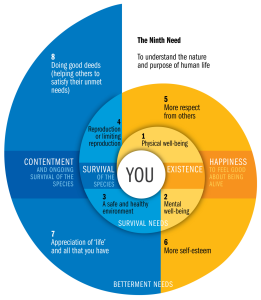Simon writes about the universal need to understand universal human needs.
The better we understand our fundamental needs, the better we are equipped to live well and positively influence the lives of others. My own understanding of human needs forms the basis of pretty much all my actions as a philosopher, writer, teacher, husband, father, friend, and so on.
In addition to the brief introduction below, I encourage you to read and reflect on my 75-word Theory of Universal Human Needs, and to explore the reading list following the introduction. You may also enjoy two related articles: The Ninth Need and Cinema Unanimity.
An introduction to my human needs theory
I have always been interested in why humans do the things they do. I am fascinated by our wisdom and our stupidity, by our need for society and individuality, and by our innate cohesion and our seemingly intractable conflicts.
Without knowing what a human needs theory was, I spent year after year travelling, observing, and thinking about universal needs — about what connects us all. Then, in March 2004, one of my brothers-in-law was reviewing an early draft of my writing guidebook, Clear Concise Compelling, and he pointed out that I had in fact written a human needs theory (without the thesis).
A ‘theory of universal human needs‘ sounds a bit pompous, but it’s an accurate title and the content (at just 75 words) is anything but pompous. And although I drew on the advice of academics (such as Dr Niki Harre from The University of Auckland) and read academic texts, my theory is not a formal academic one. Does that make it less helpful? I don’t think so (and based on countless citations of the theory, it seems many others agree), but you can decide for yourself. And that’s the key to my theory: accessibility — anyone can read it and critique it, which seems to me to be a helpful quality for a theory that attempts to identify and understand universal human needs. It is intended to be everyone’s list of needs.
So my approach relies on brevity and natural philosophy (observation, contemplation, logic), and my simple hope is that the theory proves useful. I have, in any case, put a peg in the ground.
Introduction | Article | Nautilus diagram | Translations
Further reading on human needs
Surprisingly, it seems very few humans have attempted to define our common needs. We seem to know much more about what it takes to run a car smoothly, for example, than what it takes for the driver of that car to live his or her life smoothly. Only a handful of theories relating to human needs have ever been published. Here is a list of four I recommend you explore.
- 1940s: Abraham Maslow’s Hierarchy of Human Needs
Maslow, an esteemed American psychologist, developed his hierarchy of human needs in the context of the Second World War. He sought both a psychology both ‘for the peace table’ [1] and ‘that would speak to human potential and wholeness’ [2]. The well-known 5-level human needs pyramid, which Maslow did not create, over-simplifies his theory, as discussed in the fascinating 2019 paper, Who Built Maslow’s Pyramid? by Bridgman, Cummings, and Ballard. - 1960s: David McClelland’s Need Theory
McClelland proposed three types of innate motivation (achievement, affiliation, and power) that significantly influence our behaviour. - 1960s: Clayton Alderfer’s ERG Theory
Alderfer fruitfully developed Maslow’s theory into three interrelated needs: existence, relatedness, and growth. - 1980s: Manfred Max-Neef’s Fundamental Needs Matrix
Max-Neef’s matrix distinguishes nine needs (subsistence, protection, affection, understanding, participation, recreation, creation, identity and freedom), each with four existential categories: being (qualities), having (things), doing (actions), and interacting (settings). In his 1991 book, Human Scale Development, Max-Neef also puts forward three related, thought-provoking postulates: (1) Development is about people and not about objects; (2) Fundamental human needs are finite, few and classifiable; and (3) Fundamental human needs … are the same in all cultures and in all historical periods. What changes, both over time and through cultures, is the way or the mean by which the needs are satisfied.
If, like me, you are also interested in conflict resolution, I also recommend you read John W. Burton’s article on human needs and conflict resolution. Burton argues that if it is unsatisfied needs that cause conflict, rather than innate aggression, then to resolve conflict we must direct our efforts at helping all the parties in conflict meet their human needs. A key reason I published my human needs theory is to provide a simple checklist for those immersed in conflict — or in trying to resolve conflict — to help identify the conditions for resolution.
[1] Hoffman, E., The right to be human: A biography of Abraham Maslow (Jeremy P. Tarcher, Inc, 1988)
[2] Ballard, J. A., The diffusion of Maslow’s motivation theory in management and other disciplines (2006)
